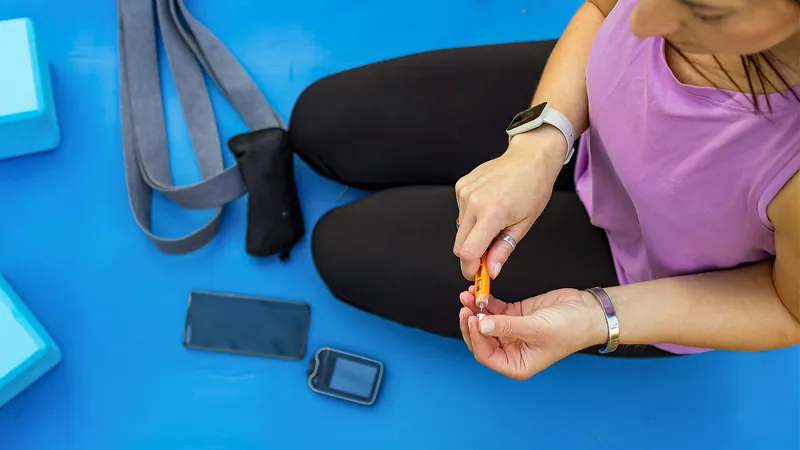
Revolutionary Study Unveils New Strategies for Type 1 Diabetes Management Post-Exercise!
2024-10-08
Author: Amelia
Recent Research Findings
Recent research from the University of Alberta has uncovered a groundbreaking approach for adults with Type 1 diabetes to effectively manage high blood sugar levels after intense exercise. Traditionally, guidelines have suggested aerobic cooldowns to regulate blood sugar spikes that can occur after workouts. However, this practice has never been rigorously tested—until now.
Study Leadership and Focus
Jane Yardley, an adjunct professor at the Faculty of Kinesiology, Sport, and Recreation, alongside graduate student Reid McClure, spearheaded a study focused on the effects of fasted resistance exercise (working out on an empty stomach) on post-exercise hyperglycemia (high blood sugar). The results challenge existing assumptions about glucose management following physical activity.
Short-Lived Effects of Cooldowns
While a cooldown following aerobic exercise can initially reduce glucose levels, Yardley notes that this effect is short-lived, revealing that relying solely on cooldowns for blood sugar management isn’t sufficient. This is significant since persistent hyperglycemia can lead to severe health complications for those with diabetes, including kidney damage, nerve damage, eye disease, and potentially life-threatening conditions like ketoacidosis.
Understanding How Exercise Affects Blood Sugar
Normally, our bodies balance two hormones—insulin and glucagon—to keep blood sugar levels stable. Insulin decreases glucose levels, while glucagon releases glucose when needed. For individuals with Type 1 diabetes, this balance is disrupted, as their bodies cannot produce insulin naturally.
Yardley explains that during exercise, muscles absorb glucose even in the absence of insulin. This can lead to significant challenges, particularly when synthetic insulin is in play, causing unpredictable spikes and drops in blood sugar levels post-exercise.
Study Methodology
The study involved participants who engaged in resistance exercises in a fasted state, followed by different cooldown methods: a 10-minute session of light cycling versus a rest period. The findings indicated that while cooldowns might help momentarily, they do not provide lasting solutions to hyperglycemia.
The Best Strategy: Combining Approaches
Interestingly, the researchers discovered that merely adjusting insulin levels post-exercise was also not straightforward, as the glucose fluctuations post-workout can be challenging to predict. Yardley suggests an optimal strategy may be to combine aerobic cooldowns with a small insulin dose, capitalizing on both the benefits of exercise and strategic insulin management.
Encouraging More Activity
Exercise offers numerous health benefits for people of all backgrounds, but for individuals managing Type 1 diabetes, it’s vital to have reliable methods to stabilize glucose levels. As new guidelines for diabetes management evolve, incorporating the latest research is crucial for effectively empowering those with the condition to engage more freely in physical activities without debilitating worry over blood sugar management.
Yardley emphasizes the goal of removing barriers for people with Type 1 diabetes, urging that exercise should be accessible and safe for everyone. This study marks a vital step towards achieving that goal and sets a promising precedent for future research and recommendations.
Navigating the Path Forward
As more insights emerge, we can hope for comprehensive strategies that will transform how individuals with Type 1 diabetes approach exercise and overall health, ultimately paving the way for improved quality of life. Stay tuned for more updates and revolutionary findings in diabetes management!









 Brasil (PT)
Brasil (PT)
 Canada (EN)
Canada (EN)
 Chile (ES)
Chile (ES)
 España (ES)
España (ES)
 France (FR)
France (FR)
 Hong Kong (EN)
Hong Kong (EN)
 Italia (IT)
Italia (IT)
 日本 (JA)
日本 (JA)
 Magyarország (HU)
Magyarország (HU)
 Norge (NO)
Norge (NO)
 Polska (PL)
Polska (PL)
 Schweiz (DE)
Schweiz (DE)
 Singapore (EN)
Singapore (EN)
 Sverige (SV)
Sverige (SV)
 Suomi (FI)
Suomi (FI)
 Türkiye (TR)
Türkiye (TR)